
Creator Kellian Adams Pletcher tells us all about her holiday-themed, puzzling interactive theatre show in Boston
Last time we spoke to Boston-based creator Kellian Adams Pletcher, she was fresh off creating Save the Munbax, an interactive live action roleplaying experience with elements of wizarding and animal conservation. This time around, she’s in the midst of preparing for her third annual holiday show, Club Drosselmeyer 1941, a multifaceted interactive experience where patrons can solve puzzles, interact with performers, Lindy Hop, listen to jazz, and fight Nazis in the process; previous editions have aligned with different years in World War II-era history (1939 and 1940) and always include a high amount of audience agency.
We checked in with Kellian over email as she prepares for Club Drosselmeyer 1941.
This interview has been lightly edited for clarity.

No Proscenium: Could you tell us a little about yourself and your background in doing immersive work?
Kellian Adams Pletcher (KAP): I started as an educational video game designer in Shanghai about 10 years ago, then I came back to the US and started working for a location-based gaming company called SCVNGR. I headed up the museums and cultural outreach part of SCVNGR and started to get really interested in interactions in a physical space- especially cultural spaces.
In 2011, I started my own indie games company, Green Door Labs, so I’ve been immersing people in stories in spaces for about eight years now, it’s just that the spaces were museums and the interactions were game-based. My first immersive theater production was Club Drosselmeyer 1939, which happened back in 2016.
I’m an addicted Lindy Hopper and have been most of my adult life. Most of my friends in Boston are game designers, vintage fashion enthusiasts, swing dancers, or jazz musicians so when I knew I wanted to do an immersive Nutcracker, it was natural that it would have to have a very gamey bent and it would have to happen around World War II.
NP: What is Club Drosselmeyer?
KAP: Club Drosselmeyer is an interactive Nutcracker in swingtime. It’s been described as a narrative puzzle room with performative elements, which is to say: it’s what happens when you build a 1940s night club with a full swing band, dancers, magicians, and acrobats; add a storyline and non-player characters so guests have to dress up and live action role play through the experience; and then add a full escape room puzzle hunt for 150 people. So, there are a lot of things to do!
My favorite part is that it’s really up to the audience how they’d like to experience it. There are people who bring their own pencils to puzzle hard all night. Others don’t even know there’s a puzzle hunt happening and just go to dance — we rewrote the entire Nutcracker suite into swing dance tempo and it’s played by an eight piece swing band. I know a lot of people who bring their parents or families and they just dress up, watch the band and the acts and have a great time of it!
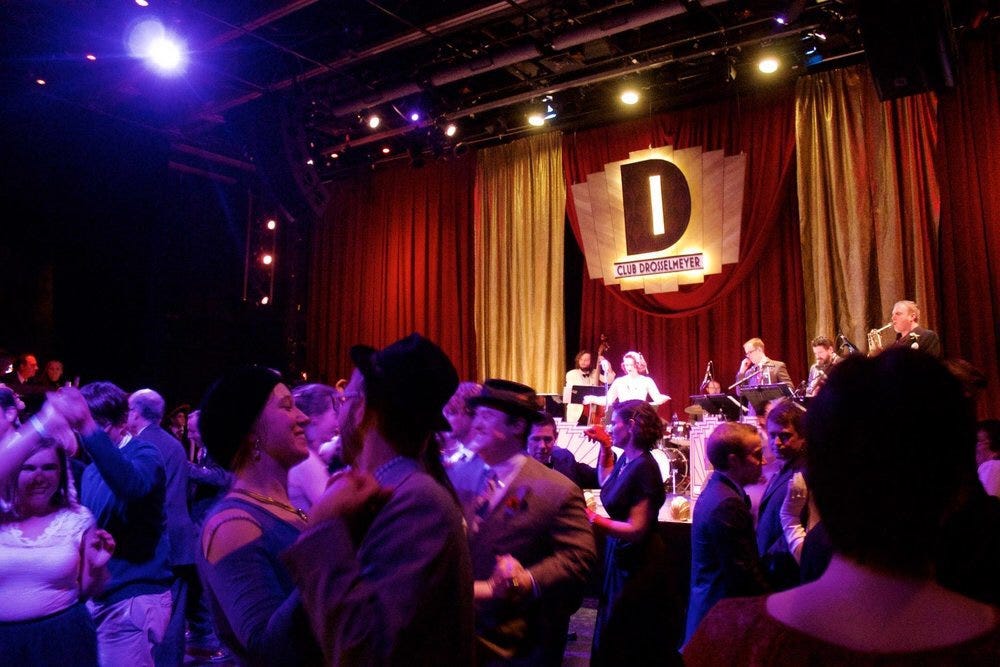
NP: When did it start and what inspired this project?
KAP: After seeing Sleep No More (like everyone, right?) I knew I wanted to try something with an immersive format but more interactive and game-inspired with more agency for players. I wanted players’ actions to really matter and affect the evening! After the escape room craze started, I loved this idea of being immersed in a space with a team and a goal, but I always found the story and environment a little lacking.
I went to a ballet performance in Cambridge in 2015 and realized that the Nutcracker would be the perfect sandbox to experiment with this type of production: it’s well-known enough that people have a baseline for what’s happening, but the story itself is very vague and modular. It comes with an incredible soundtrack that everybody recognizes and it’s beautiful! Sugarplums, drag queens, dancers from all around the world, androids, scientists, giant rats, what else could you want in a story?!
NP: Why choose to tell a story based upon American history in an immersive format?
KAP: I’m a Lindy Hopper and a lot of my community is connected to the art and style of the World War II-era so it was a really natural fit for me, that was just a space where I had a lot of resources. Also it was 2016, and I was seeing so many historical echoes in the rise of fascism all around the world and the demonization of immigrants and certain ethnic groups, so it seemed like a really natural tie in. It actually never occurred to me to tell the story in any other way.
NP: How much of Club Drosselmeyer is based upon fact and how much is fiction?
KAP: A surprising amount of the story is based in real history, though people might not recognize it at first blush. I heard this excellent quote from Edward Gorey:
“If you create something, you’re killing a lot of other things. And the way I write, since I do leave out most of the connections, and very little is pinned down, I feel that I am doing a minimum of damage to other possibilities that might arise in a reader’s mind.”
I was so excited when I read that quote because I feel exactly the same way. I like to put in real events and characters that could have plausibly existed but then leave the audience to write it the rest and create all of the extra possibilities — and hopefully do a little digging in the historical world that these characters live in. It’s so much more fun than just making everybody listen to a strict, linear story that only has my perspective.
I start reading up on the details of the “Drosselmeyer year” about a year before the event. This year is 1941, so it’s so jam-packed with emotional, sensitive content about Pearl Harbor and I felt that I needed to do my best to be sensitive about the audience’s agency. Originally I was like, “What, you’ll have to foil the plot of a second Japanese attack?” But then, what if the audience loses? Do we re-enact what it would feel like to have Boston Harbor bombed? If you decide to “black hat” the game, does your city gets bombed? That’s just too much — 2018 has been a hard year for people, I had to give them a break.
Get Kathryn Yu’s stories in your inbox
Join Medium for free to get updates from this writer.
SubscribeSubscribe
So we focused a lot on the 1941 creation of Army and Navy Cryptography departments, which was a totally new field then. The Navy especially was recruiting a lot of women from the Seven Sisters schools here in New England, so it’s a story that’s really tied to our local history. Suddenly, women who were educated in linguistics and math and science were really valuable: the armed forces wanted to recruit codebreakers who couldn’t get drafted. I also took content from the creation of the WAAC and the WAVES in the Army and Navy, the first time that American women were fully soldiers in the armed forces rather than just volunteers or civilian workers. When I started focusing on those stories rather than the devastation of Pearl Harbor, things seemed to come into clearer view. The history always informs the direction of the show.
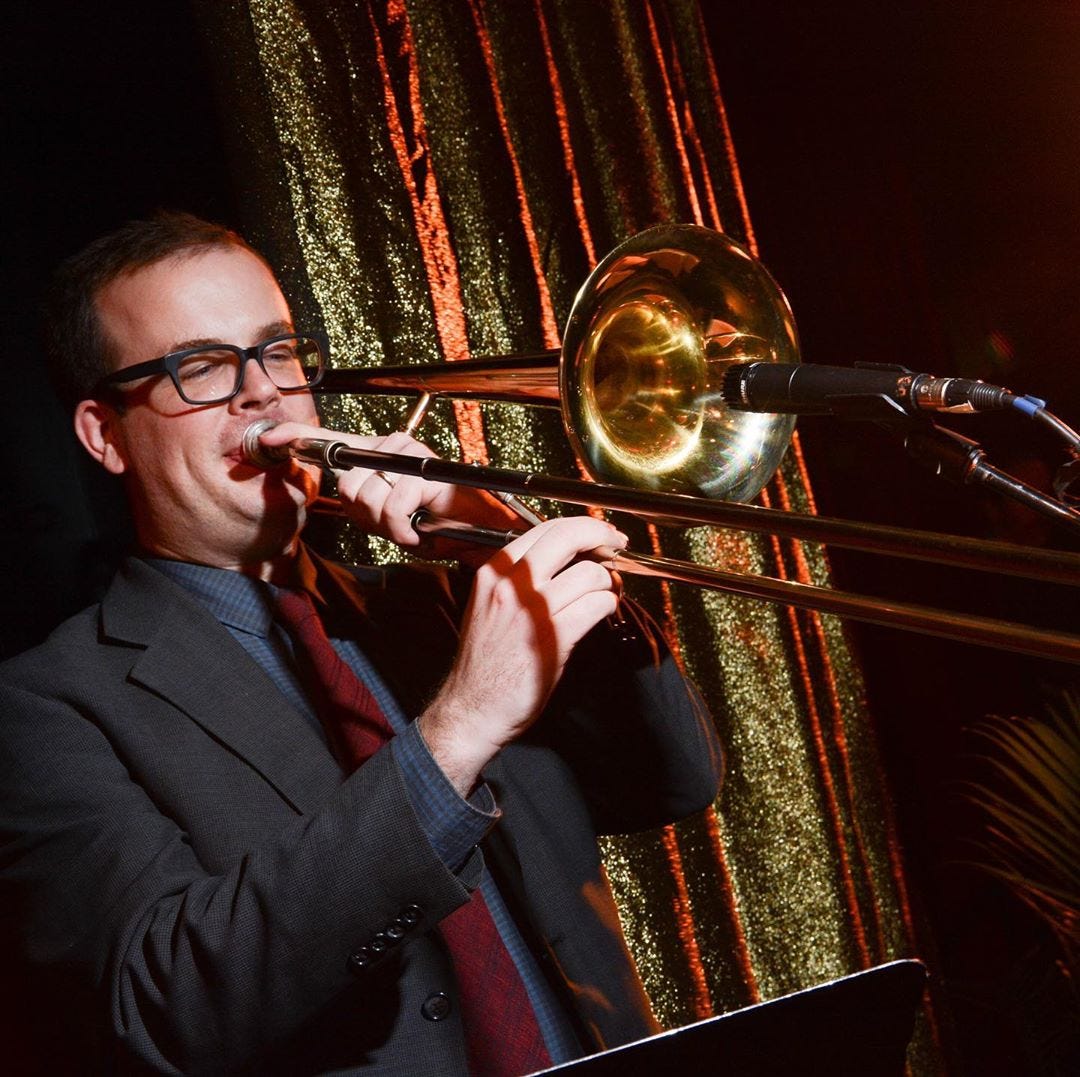
NP: How does each “year” (1939, 1940, 1941) influence the content?
KAP: It’s interesting that Club Drosselmeyer is a Nutcracker show — traditionally a Christmas show. So it happens in December when we’re already naturally looking back at the year [past]. I go into writing the final script already in that mindset, so it naturally shakes out to have the flavor of the year we just came out of.
I built Club Drosselmeyer to be a four-year cycle starting in 1939 — or 2016. It was meant to get me through these sort of angry, sniping, coarse Trump years. I always try and remember that the US has been through worse than this, and though it might not seem like it, we’re really doing better than ever in terms of civil rights. That’s not to say that it was amazing then, just to say that it’s easy to forget how bad it was 60+ years ago! So the show is sort of a reminder to me at least, that we’ve been through bad times before.
The year 1939 — or 2016 — was about big choices and feeling that “it could never happen here.” I try to remember that in the late ’30s while fascism was taking over Europe, people just lived lives where they had breakfast and did their work and thought a lot about how messy their living room was and whether or not they should go to the movies that night. Life is pretty normal, until it’s not. So in 1939, I wanted people to remember that bad things happened right under the noses of good people living their lives.
Club Drosselmeyer 1940 was a lot about immigration and what was done and what wasn’t done to help refugees. A lot of people now feel really angry that Jewish people were turned away at the US border — and they were — but the US also took in more Jewish refugees than any other country in the world at that time. So we were horrible, but less horrible than we could have been. Sort of a mixed message, but something worth considering. A lot of people don’t know that America had a very strong Nazi or Nazi-leaning party in 1940, called the America First campaign. (I can’t make this stuff up.) Its figurehead was Charles Lindbergh, the aviator, who was a white supremacist with Nazi sympathies and this party had thousands and thousands who showed up at the rallies — saying a lot of the same stuff that the Nazis were saying. Saying a lot of the stuff MAGA rallies say now.
Pearl Harbor changed all that in 1941, but we narrowly dodged that bullet. It was also really nice to see stories of private citizens and private businesses like the “Leica Freedom Train,” a camera company that put itself on the line to get over a thousand Jewish refugees into the US under the guise of employment.
Now in 2018… and 1941, it ended up sort of being the year of #metoo, which I was surprised about. I don’t think Club Drosselmeyer is the right format to deal with issues like racism or sexual assault, but it’s a good place for us to remember how recently it was that women were not full citizens with all of the legal rights of men. And I think in 2018, the veil started to come off and we saw that maybe we hadn’t come as far as we thought we had. Countless women were still preyed upon by these sacred old-boys networks and didn’t have the full protection of the law. It’s still strange for us to see women in positions of leadership and we still “are okay with women, but just not THAT woman telling us what to do.” We were thrilled to see more women elected to the US government than ever before… and even that is still so much less than 50%.
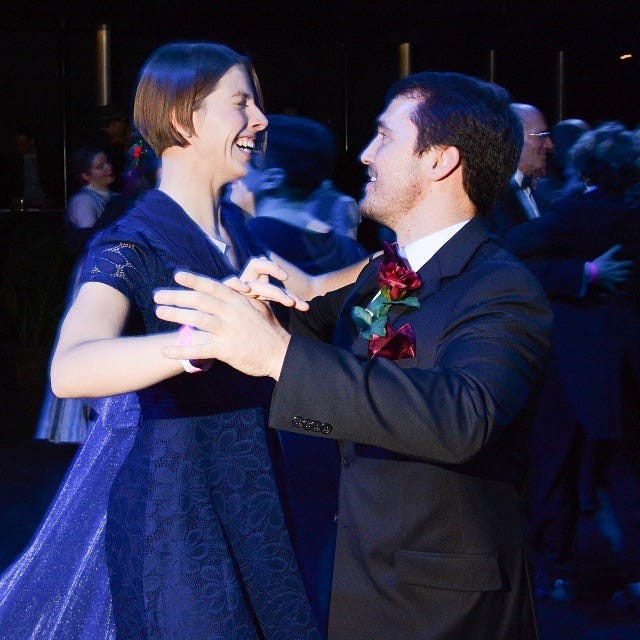
NP: So how much power does the audience have to change the course of events in the show?
KAP: A lot. It’s been an interesting balance figuring out how to give audiences agency, so their actions matter, while still making the decision points streamlined and achievable so it doesn’t feel like a campy “Edwin Drood” or “Shear Madness” knockoff.
The first year, our solution was to give people agency only after they’d achieved a certain level of accomplishment within the show. The people who made it through all of the story and puzzles first could decide for everybody else. That was fun, but competitive, and some people were really mad when the winners went “black hat” and chose the ending that benefitted the villain.
The next year we tried to iterate into a two-level system where people could complete smaller amounts of story/puzzles and vote for a final ending while the top teams who completed everything had the ability to override votes or change nuances of the decisions.
This year we’re trying a little something different where smaller amounts of activity can really impact side-quests while top teams impact the larger story… with some twists. But I don’t want to give too much away!
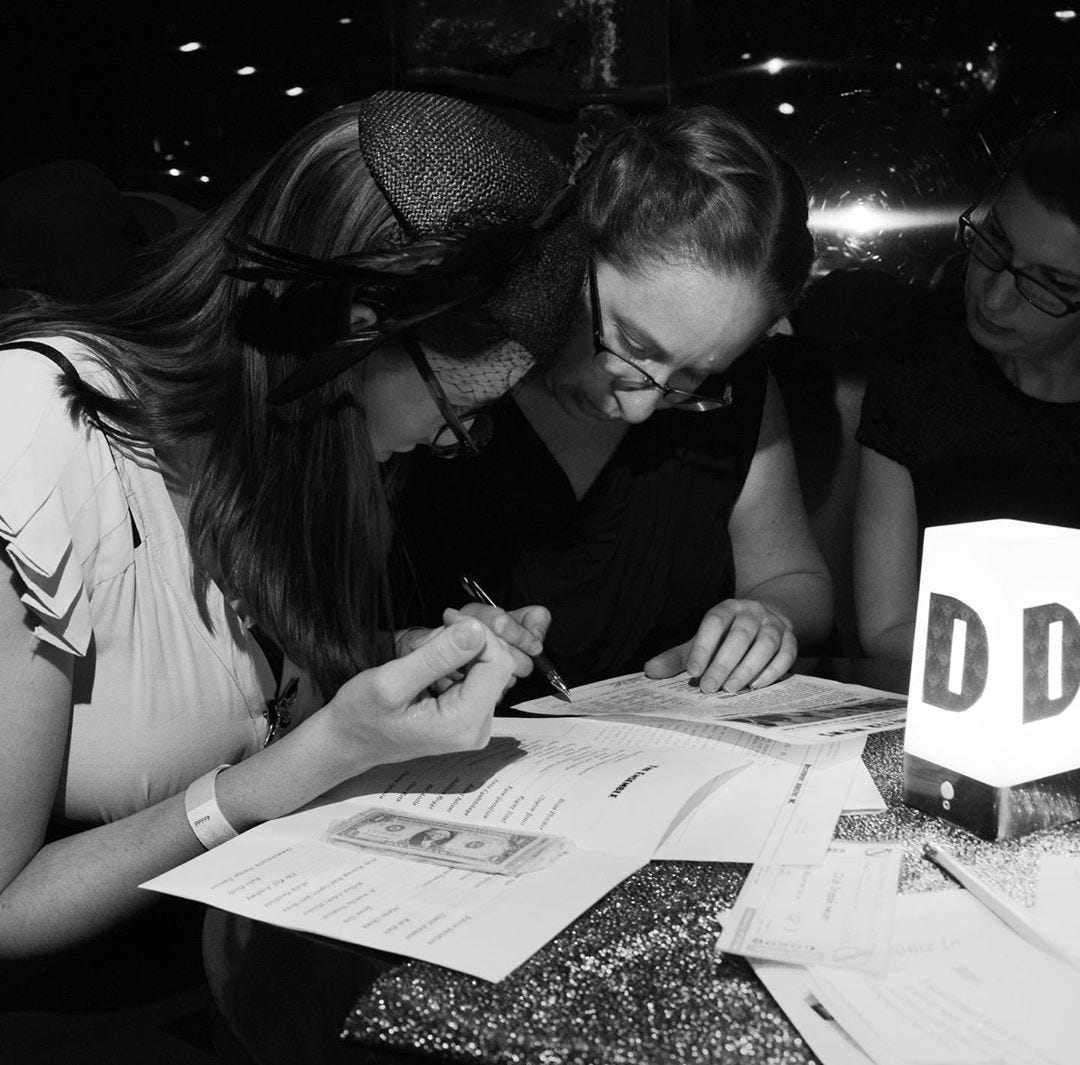
NP: And do you have to be a puzzler or swing dancer to enjoy the Drosselmeyer experience?
KAP: Not at all. We found that about 70% of people who attended the show in the past two years touched at least one puzzle — so that means 30% of the people there didn’t know that there were puzzles to do, or didn’t care, and still had a great night dancing, interacting with characters, having drinks and watching the floor show. Out of that 70% of people who did the puzzles, we found that maybe only 30% of them were “heavy puzzlers” and spent the entire evening cracking puzzles. A larger percentage of the audience just did maybe one or two puzzles and then spent the rest of the time doing other things.
Another thing that we thought was really fun was how people formed teams depending on what they wanted to do. Guests especially talked to us about “introvert-extrovert” pair-ups where half of the team would run around talking to characters and farming puzzles to bring back to their teammates, and the other half would stay put and crunch through the puzzles as they received them.
The dance floor is always packed and I’d say it’s only half-full of people who are regular swing dancers. When you’re in a club with a full swing band and a full floor and you’re all dressed up, it’s hard to resist! Even still, a lot of people come just to see and be seen, have cocktails, talk to their friends and watch the evening unfold so, it’s really up to the guests how they’d like to experience the night.
Club Drosselmeyer 1941 runs December 16–21 on select nights at Club Oberon in Cambridge, Massachussetts. Tickets are $49–85.
No Proscenium is a labor of love made possible by our generous Patreon backers: join them today!
Brought to you in part by The Johnny Carson Center for Emerging Media Arts, who are seeking faculty candidates.

In addition to the No Proscenium web site, our podcast, and our newsletters, you can find NoPro on Twitter, Facebook, YouTube, Instagram, in our Facebook community Everything Immersive, and on our Slack forum.




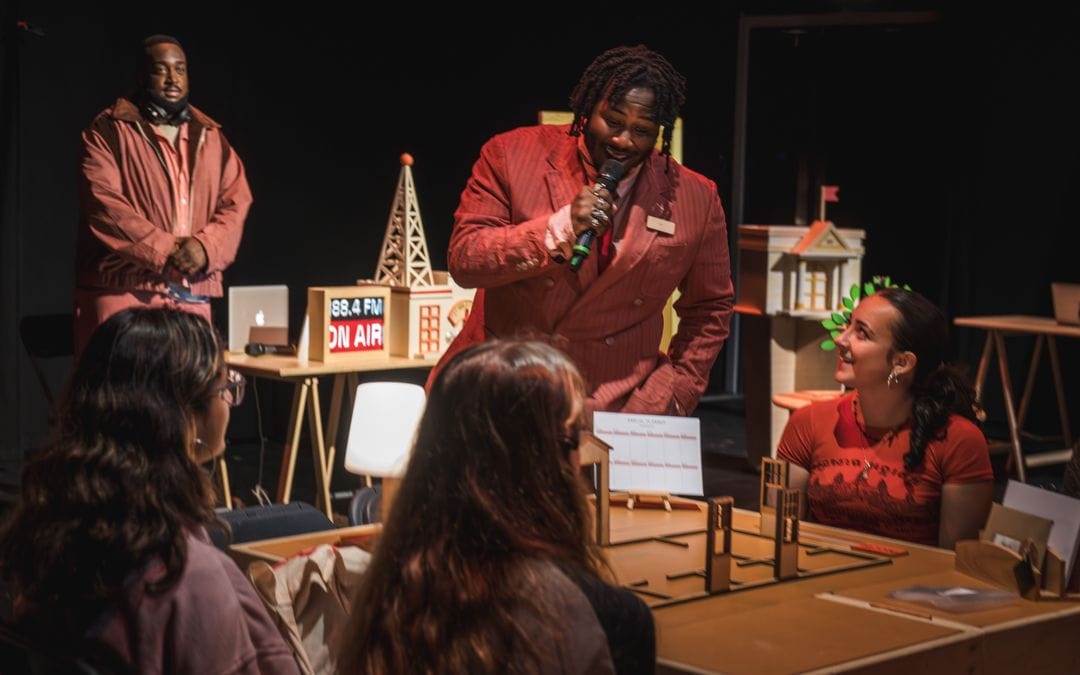















Discussion